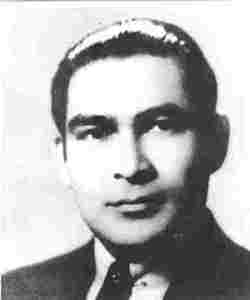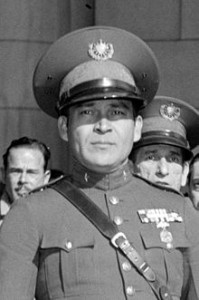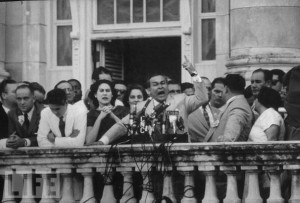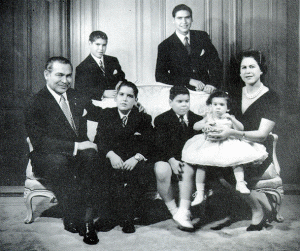We would like to refer today to one of the characters most controversial and rightly rejected of the battered Republic of Cuba, but certainly not less important and of vital presence in the twentieth century, twice dictator and once constitutional president, Ruben Fulgencio Batista y Zaldivar.
Born in 1901, in Banes and on a farm about 20 miles from Banes beginning of the century, the La Guira, in the countrysite. The son of a sharecropper farmer who had been a sergeant in the Liberation Army and had fought under the command of Jose Maceo. Natural son of this farmer, doubly illegitimate child because his father never married, you know which motivated a large social rejection towards the family, with Carmela Zaldivar and across the four children he had the only one not recognized was the eldest, who was Fulgencio, which was inscribed with the name Rubén Zaldivar and not until 1921 or 1922, in a document of the Army, which is in Batista’s military record where the first official note the name of Fulgencio Batista y Zaldivar, a note of the administration of staff where the soldier says Rubén Zaldivar has been registered by mistake with that name and is actually called Ruben Fulgencio Batista y Zaldivar. Then in later processes it will undertake to legitimize this name, in the eyes of bourgeois legality and society of the time, or try to justify it.
As the son of a sharecropper farmer I said before, was born into extreme poverty, that is, born with everything against him. He was also a mulatto, mulatto, poor, illegitimate child, and in the most remote region of Cuba, any futurist would have ensured a life of hardship and misfortune. Not so, four or five he began working as an agricultural laborer in the region of Banes, until age seven when his family moved from La Guaira to the town, given his mother’s connections with family Zaldivar Carmela Diaz -Balart, whose trunk was a lawyer or a member of the Bar of the United Fruit Company, politician and chief of the area.
As Carmela links with the family as a maid Diaz-Balart and opposed by the father who always had the worst relationships, Batista gets a college grant the Friends, school founded by Quakers, and the initiative and with the subsidy United Fruit Company. But it is a grant anyone the getting, but is a scholarship for the evening session, school friends, because the day fulfilling the demands of his father still works as an agricultural laborer and this shows two things, the great desire for a part and the other intelligence of this child who will win the primary, learn English and earn a great admiration for the United States. After Carmela dies Zaldivar, and at variance with his father, he abandoned Banes.
First, for a few months and then for the rest of his life and both times, as in the third time, is going to do with family recommendations Diaz-Balart, one of whose sons, grandfather of the late Representative U.S. Chamber of Lincoln and his brother Mario, will lock up a close friendship since childhood that will have major implications in the life of Fulgencio Batista during his life, the life of the latter and the Diaz- Balart.
Work on the Railways and then enter the Army. In the army continues to study and when you stand on the farm de Zayas as you know, there is the famous story of the soldier Zayas calls this moth because it is the only member of the garrison prompted the possibility of having access to the library de Zayas . At this time it is stenographer, typist is, teaches shorthand, typing and English and won a position as stenographer in opposition sergeant and was assigned to the staff first, then to the Cabana Fortress to military courts where you to establish relations with a number of lawyers involved in the political organizations of all kinds of different categories or classifications ideological fighting against Machado and keep in touch with these lawyers, seeking their overcome general and his political advancement.
At this time participating in the ABC, the first path, throughout this first path also Batista always love of money, shares his duties in the Army, as a conspirator with the sale of fruit, a brakeman working with private lessons San Carlos Academy, with another Academy that he founded, in short, does everything he can to make money, and get a machine, a car which will then help him play a prominent role in the September 4, 1933.
In the process of training apart from the series of experiences that accumulates, there is something very important. First Batista was not an intellectual. Now, Batista was not as stated, and I stress this, an illiterate. From 1934 Juan Luis Martin, a journalist of the time, he organized a sort of college for free in Cuba studying History, American History, World History, Geography, Public Speaking, Law, International Law, in order , a string of subjects having to do with the activity of a politician and which has teachers such as Jose Manuel Casanova in the case of the sugar economy, and as Ramiro Guerra y Sanchez in the case of History of Cuba.
According to all the memories from friends and enemies, Fulgencio Batista, was a very cold, very serene, very conniving, an able politician. Around Pablo de la Torriente Brau in one of his writings says that the most skillful politician who has given the revolution of 30, the most skilled, the most conniving of all is Fulgencio Batista in one of his letters, in Letters Crusades. Moreover everyone, circumstantial allies, temporary and permanent allies allies, even enemies, agree that their direct, personal, outside the gallery, was a nice guy, friendly, witty Creole, a charismatic type, something that not correspond either to the public image that we have formed of him or the propaganda that has become logically about her figure.
He was extremely ungrateful, and a man extremely unfair with stinginess. In the judgment of divorce from Elisa Godinez first glimpses of the trial, three, four sessions, a highly controversial judgment in the distribution of inheritance are discussed apartment buildings, are discussed actions, blocks of shares, in short. After Batista discusses the silver spoon set such, the game covered with twelve pieces, the game of tea or coffee set. This stinginess is a part of their proverbial and well proven ambition created him great enemies and great disloyalty historically fatal for him.
José Suárez Núñez, speaker of the tyranny, economic problems remain in exile, shortly after the fall of the dictatorship, demanded money. Batista denied it and Suárez Núñez responded by writing a very interesting book that I recommend to everyone who has asked not to be called “The major culprit” where all the dirt out that he knew Batista, from the fact that for each delivery to the State, the supplier Batista charged a ten percent commission to others, many more outrages and iniquities.
The same happened with Tabernillas, the Tabernillas broke and then asked to pay money to Batista mortgages and loans and stuff. Denied Batista, Batista did not give a penny to anyone, and good responses were a series of letters from denostando Tabernillas Batista. And the same happened with Colonel Barrera, first military leader in the Sierra Maestra who asked for help, and after the overthrow of Batista tyranny and responded just as ungrateful.
His disloyalty and ingratitude hurts demonstrated by its attitude toward Paul Rodriguez in 1934, organized together with him and another group of sergeants on September 4, and Batista takes advantage of that Paul was Machado, Machado openly and publicly apologist Machado and organizer festivals in the Enlisted Club Columbia Machado. It takes advantage of this, his attitude and also unfair to their criminal instincts that I have not touched yet, but it is one of the characteristic features of the figure, is reflected throughout his string of crimes, including murder of Sergeant Mario Alfonso Hernandez The soldier Mario Alfonso Hernandez, who was plotting against him. Fulgencio Batista according to opinions of several of its experts had a central guide, compass center, his ambition for power and money.
Another feature of Batista’s Creole and shares with many other Cuban personalities from the center, left and right which is a womanizer. And the last thing I want to add something interesting, Batista had a brother. Well that is a trait common to the political and nonpolitical, is a very distinctive feature. But there is another very interesting thing is their religious beliefs. Batista was Santero and Spiritualist, and had a brother-they were four Ermerindo, the second died, which was santero and many of the most important political decisions in this country were faced with a range of options, a preferred, alternative and rejected the other because Snails Ermerindo brother decided that the best decision to be taken at a time when the army chief Batista and another President, was this.
And there was, in Galiano Street, a holy woman named Antonia Gonzalez and Antonia Batista put in contact with Maceo, and Batista took many decisions Antonia Maceo mediating under the guidance of Antonia Gonzalez, which is a very interesting about the processes of decision making in this country. This feature resembles Batista other leaders like Frances de Gaulle, who was a spiritualist and American U.S. president, Ronald Reagan, with anonymous figures and power behind the scenes, showing that it is not exclusive to the developed countries have certain beliefs that we can not prove cienficamente and less application in policy decisions. that affect many.
IN HIS FAVOR
Fulgencio Batista was undoubtedly an intelligent man, lights, was a skillful politician despite having no education, came from a poor, rural and marginal. He entered the army as a way out of poverty and became sergeant stenographer there. It’s a guy with a huge star, helped by his audacity and his political skills because he comes to the fore in this country following the fall of Machado, taking advantage of a tumultuous period of the country where the movement of students and sergeants, the latter belong Pablo Rodriguez and Eleuterio Pedraza, Batista gets by in the turmoil that of Columbia students to become a figure.
Batista is one of those characters that arise in turbulent periods of history as a kind of meteorite to appropriate what does not belong. It was also a skilled politician to negotiate, it must have been because he was governing the destinies of Cuba without being officially chosen from 34 to 40, the “strong man”.
Since mid-1934 a committee of the Police Association Foreign invited by the Cuban government had visited the island to study the economic and socio-political landscape of the country to offer possible solutions to the national crisis. After his work, said Commission recommended the implementation of a reconstruction program, proposals drawn reshaping the guidelines to follow for Batista and colleagues from the oligarchic groups, which settled after the revolutionary situation in 1933 and directed the process consolidation of the armed forces began to implement those guidelines that were more convenient.
Initially the work was directed towards the rural population as well as being the most affected by illiteracy and poor health, was most disappointed by traditional politics and did not have a definite orientation after the failure of revolutionary popular movement in 1935. The situation in the field was well known for their social as Batista, so it was very difficult not to become the first sponsor of a major campaign to support and enhancements to the peasantry, including and especially medium and small settlers .
On February 27, 1936 the Council of Secretaries issued Decree Law No. 620 authorizing him to appoint members of the military to provide primary education services in places where there were no schools or likely soon to be established. The same decree law reserved to the Secretary of State the power to inspect the operation of the classrooms from the technical point of view which placed under the direction of the military headquarters rural primary education. To finance the schools were created special funds from the income received by certain taxes. Such a sure way to bring the executive control large sums of money that would be manipulated by the military top. To give an idea of the dynamism undertaken, and by 1937 there were 40 missions and a thousand schools. Batista and his advisers could soon structuring a system of rural education record.
Shortly after the regime applied new social measures directed primarily towards health field whose long neglect ostensibly to beat the Cuban population. On March 30, 1936 by Decree Law No. 705 provided that the direction of health and welfare in cooperation with the Finlay Institute to organize a sanitation service. On that same date the decree law number 706 determined to create the National Tuberculosis and its directors as well as some civilian figures was located a senior army officer. Began operating only with the Sanatorium of Hope in the capital, but also allowed for the construction of a lavish sanatorium in Topes de Collantes, former province of Las Villas, concluded under the first presidency of Batista.
At the same time the decree 707 provided for the organization of the Civic Military Institute was built in the town of Ceiba del Agua for education of orphans of parents, peasants, workers, police officers and enlisted men of the army and navy constitutional died during the performance of work in services. The center had its board of directors headed by an officer appointed on the headquarters and three other officers. This March 30th Legislative Decree number 708 constitute it ordered National Public Assistance Corporation and from August the rural schools and civic military with the four institutions mentioned paramilitaries were subordinate to the Corporate Council on Education, Health and Welfare established as the Central . His leadership rested on a board of five members of whom the majority were army officers Constitution.
The income funds nurtured these institutions ran to account for a percentage of total revenue from the national lottery ranging between one and three percent as well as taxes, levies, fees and revenues that were implemented in different special laws or and utilities provided by charity fairs and festivals and other similar acts. That way the state assumed a proactive role by providing funding sources for corporate institutes. In summary, only the concept of corporate subsidy institutes have arrived home with almost seven million pesos. Was thus opened a vast field for military maneuvers.
Now what is the phenomenon of Batista? In the last stage of his dictatorship Joaquin Martinez Saenz President of the National Bank idea a very effective formula to mobilize large accumulated liquidity in banking since the last years of World War II and force through a complicated system of compulsory state bonds, to direct it to a number of state plans for economic development. This system was doctored to make it a formidable method, unpublished until then to embezzle the funds available, beyond the sterile state budget, so badly beaten by all the politicians in power since the beginning of the Republic, for almost every president before stealing directly of public funds except Carlos Prio who used more subtle methods, now called “influence peddling” or “use of government information for personal gain.” What did Batista? He managed to have a single or majority share in each of the projects of economic and social development sponsored and funded by the state-owned banks, or BANDES, BANFAIC, Bank for Foreign Trade, National Financial. No one in that has no involvement at all had interests except those having to do with U.S. companies.
Afterwards, during the constitutional mandate of 1940 to 44, you’ll find something interesting is going to have within its Executive who will be considered after illustrious figures of the culture of this country as Medardo Vitier, Jorge Manach and Juan Marinello, among others. He achieved in 1938 lay in the same table, and the support and involvement of its Council of Ministers, the Communist Party and the ABC, the two most distant ideologically in the political spectrum. It was particularly bold in difficult situations because it always becomes master of the situation. The same thing happens when you give the coup in 52 where the gap advantage has led to the death of Chibas to attack power. No doubt it was very clever, but mostly it was an extremely ambitious man.
Batista was even a plan to seize the Cuban Telephone Company, a subsidiary of the parent Cuban American, the powerful ITT, a major U.S. transnationals of the time. Batista had been postponed since 1952 requests made by the firm to authorize it to increase their service fees as a precondition for investing in the expansion of telephone service, a kind of corporate blackmail. Batista was confident that, with its delay, come down the value of listed shares by buying them then go gradually, along with its partners, to become the majority group. Vain pretense.
Nothing less than the celebrated Foster Dulles, Secretary of State General Eisenhower ordered him in a personal letter to end of access requests from the ITT. Batista, swift and quick, hurried to sign the red carpet in a Hall of Mirrors that even smelled of gunpowder and blood of battle staged in a luxurious room the day before, March 13, 1957, during the assault on the Presidential Palace .
There is no business of state funding at the time of Batista that he had no involvement. There is a construction in which the builders of the contract holders would not have to give the corresponding bribe Batista and this was done topless. Even went so far that some businesses like Windward he imposed that to give permission had to happen to your property part of the land. The casino business of games, which began to take off in recent years in the first place was a sinecure particular the National Police Chief Salas Cañizares but when this is killed, Batista joined his vast personal income Through his brother Roberto Fernández de Miranda. The number of properties Batista was just amazing, it was becoming the monopoly owner of freight transport by road had only two or three small companies to buy, going on that path in air transportation in the capital and only urban transport in the shipping had achieved little.
HIS PROPERTIES
For your daily grinding capacity, the central Washington, Andorra and Evidence, which belonged to him, Batista became the 14th landowner and 6 th among non-US equity. It also had shares in the Gulf Atlantic Sugar Company, the largest U.S. consortium in its field in Cuba and the second group of ground capacity. And it was probably also holds shares in the central Ulacia and Heart. He owned also one of the 40 largest colonies cane. His interests extended by several real estate companies, developers and building both in Havana and Varadero. Owner, at the spa, Kwama sharing, multiple buildings in the capital and vast land in Miramar, Nuevo Vedado, Puentes Grandes and Expansion of Almendares.
As regards media, the newspapers were his alert and People, People magazine, the RHC Cadena Azul radio stations (Radio Reporter) and the Cuban National Circuit, the Eastern Channel Radio, Union Radio and TV Channel 12 and Publishing Company Noon and Investment Company Radio. Cuba also sole owner of Aeropostale, senior partner of Q Airways, and chief among private partners Cubana de Aviacion. Owner secret of American Society of Road Transport and other transport companies and shipping Vacuba partner.
Among other properties, also belonged to Batista Oasis Motel (Varadero) and the Hotel Colony, Isla de Pinos. The developer Windward Tourist Center (Marina Hemingway). French Beach Land Company. The Tourism Development Company of Trinidad and S. A. The Territorial Beach Gerona. The West Indian Hotel Company, which projected in the Parque Marti, G and Malecon, a hotel of 700 rooms and a cost of 25 million pesos.
If the salary of an Army general was not more than $ 400 pesos a month, and the President of the Republic was in 1958, $ 12,500, how could Batista amass a fortune estimated at 300 million? For data released by William Jimenez in his books IS offers an answer. “The way we took advantage of the funding policy and concessions that promoted the state bank or through their ownership or through third collection of high imposts on employers benefit, for bribery, embezzlement and charges, including those of the forbidden game, which was the main beneficiary, and 30% charging of fees that contractors paid cash for works concessions received, whose credits Batista personally supervised. ”
Fulgencio Batista in his first marriage to Elisa Godinez had three children, Mirta Caridad (April 1927-2010), Elisa Aleida (born 1933), and Fulgencio Rubén Batista Godinez (1933-2007). In his second marriage, to Marta Fernandez Miranda had five children: Jorge Luis (born 1942), Robert Francis (born 1947), Carlos Manuel (1950-1969), Fulgencio Joseph (born 1953) and Maria Marta Fernandez Batista. He also had a daughter, Fermina Lazara Estevez Batista in 1935.
Fleeing Cuba, Fulgencio Batista was first established in the Dominican Republic, then in Madeira, later in Estoril, outside Lisbon and finally in Guadalmina, near Marbella where he devoted himself to writing books for the rest of his life . It was then president of a life insurance company with investments in properties and loans on the Costa del Sol in Andalucia. Batista died of a heart attack on August 6, 1973. Fulgencio Batista was buried where now stands beside the remains of his second wife Marta Fernandez at the Cemetery of San Isidro, Madrid.
Wiki/GuillermoJimenez/Bianchi/Tabares/InternetPhotos/YouTube/TheCubanHistory.com
The Cuban History, Hollywood.
Arnoldo Varona, Editor



 A Man named FULGENCIO BATISTA. The Whole Story.
A Man named FULGENCIO BATISTA. The Whole Story.






